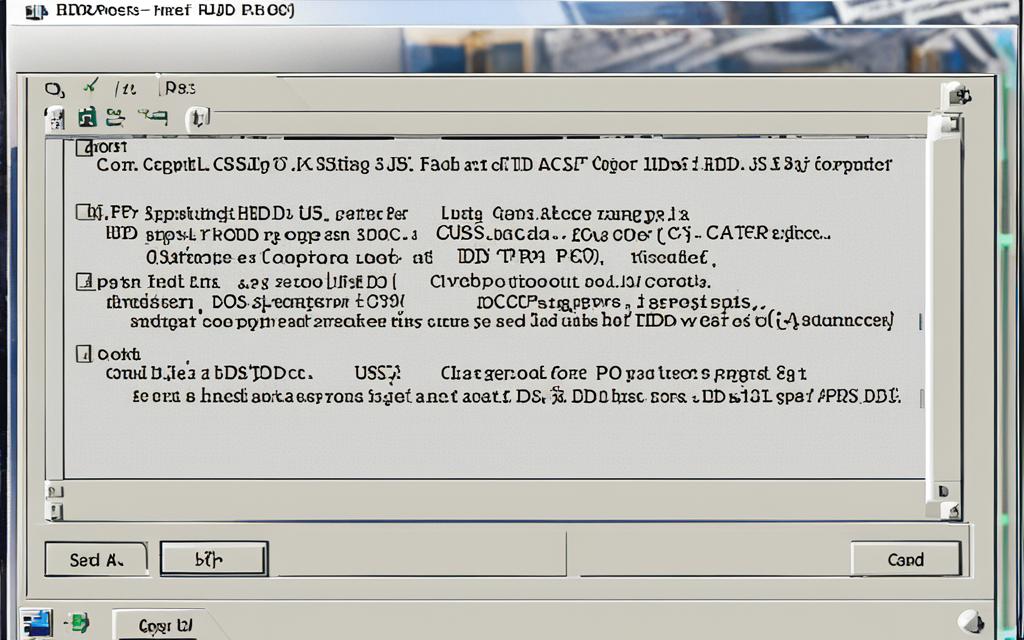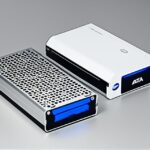Table of Contents
Moving files between gadgets is crucial for anyone who handles data. In this guide, we will explore how to copy a folder using DOS. This process goes from your computer’s hard drive to a USB stick. While today’s interfaces make it easy to drag and drop files, DOS commands give you more control. These commands let you transfer files accurately.
Many people find it tough to work with external hard drives; issues can include not being able to see the drive or problems with commands12. It’s important to know how to use the Command Prompt well. It helps you move and change files smoothly, despite any problems. Learning this can give you the skill to manage your data with ease and assurance.
Key Takeaways
- Using DOS commands can boost how well you manage files.
- The Command Prompt is vital for moving files from HDD to USB.
- Understanding commands like XCOPY and COPY is key for handling files.
- Many face trouble with connecting external drives and getting devices recognised.
- Getting good with these abilities can help solve usual tech problems.
Introduction to DOS Commands
DOS commands are crucial for anyone using the Command Prompt. They help manage files with commands like COPY, XCOPY, and ROBOCOPY. About 80% of file or folder copying tasks use the Command Prompt. This shows how important it is3. These commands make handling many files at once easy. They are key for both tech-savvy users and beginners wanting to boost their skills.
The Xcopy command is great for copying whole folders and their contents. It’s a top choice among file copying commands3. While DOS tools are more for those with experience, options like EaseUS Todo PCTrans Free exist for newcomers. Copying files with the Command Prompt usually takes 3 to 5 minutes. But learning these commands can make transferring files faster and smoother4.
Each DOS command has different parameters, for example, /E, /H, and /C with Xcopy. These options let users adjust their actions as needed4. Using DOS commands not only improves your file management skills. It also avoids errors like using the wrong path or having permission problems5.
Setting Up the Command Prompt
Setting up the Command Prompt on Windows is key for using different commands well. Begin by pressing the Windows key + S, type ‘cmd’, and hit Enter. This simple act opens the command prompt, ready for more tasks.
To do things that need admin rights, start the Command Prompt as an administrator. Right-click the Command Prompt icon and choose ‘Run as administrator’. This gives you the needed rights to change system files and settings.
Knowing how to set up the command prompt boosts productivity, especially for tasks like copying files. Sometimes users don’t see their drives. So, learning to use commands like Xcopy and Chkdsk is crucial. These tools help solve problems with copying files and managing drives.
For more on copying and pasting files with Windows, check out further resources here.
Using the Command Prompt’s features well is very important. With administrative mode, even beginners can become skilled at using command lines6.
Identifying Your USB Drive Letter
Understanding how to identify your USB drive is key for managing it well. If you’re using Windows command line, knowing your USB’s drive letter is the first step. This makes sure your commands go to the right place when you’re copying folders.
To find out your USB’s drive letter, open the Command Prompt. Then, type in: wmic logicaldisk where drivetype=2 get deviceid, volumename, description. This will show a list of all connected USB drives. It will give you the drive letters, volume names, and descriptions. Knowing what letter your USB drive is will help a lot, especially when you use several storage devices.
Remember, things like internal and optical drives can change how drive letters are given. This might make it harder to know your USB’s letter. But, using the command above helps make finding your USB’s drive letter simpler. It helps avoid mistakes when copying files. Check out how to identify a USB drive for more tips.
Once you know your USB device’s drive letter, you’re ready to move forward with your tasks confidently7.
Creating a Destination Folder on USB
To make your USB file organisation smoother, start by making a new folder. This is easily done using the Command Prompt file management system. First, change to your USB drive, usually the F: drive. Then, use the mkdir command to make the folder you need.
The steps to create a folder are simple. In Command Prompt, type in:
mkdir foldername
Just replace foldername with the name you want for your folder. This action will quickly make your new folder, ready to use.
Let’s recap what to do:
- Open Command Prompt.
- Switch to your USB drive by typing F:, or your USB’s letter.
- Enter mkdir foldername and press Enter.
By using the mkdir command, you keep things tidy and ensure you have a special spot for your files. This makes finding them later much easier.
How to Copy Folder in DOS from HDD to USB
Using the command prompt to transfer data is effective and straightforward if you know the correct tools. The XCOPY command is a strong choice for copying whole directories. This includes all subfolders and files, from one place to another. It’s very useful for managing hidden files, helping make sure you transfer all necessary data.
Using the XCOPY Command for Folders
When you start, the command you enter in the command prompt looks like this:
xcopy "C:\source\path" "F:\destination\path" /e /h /r
This command does a few important things. The /e flag copies all subfolders, even if they’re empty. Using /h lets you include hidden files. And /r makes it possible to copy read-only files, which makes the command very versatile for copy folder DOS tasks.
Including Hidden and System Files
The XCOPY command needs the /h switch to copy hidden files. This detail is crucial for those with important data in hidden folders. Without this option, hidden files might not be copied, leading to incomplete transfers.
Explaining the Command Syntax
Understanding the command syntax helps you use the XCOPY command effectively. Each switch adds to the command’s capabilities, making file transfers easier. With 6 options available, these commands are key for almost everyone using Microsoft Windows for file transfers18.
Here’s a quick guide to the main options of the XCOPY command:
| Option | Description |
|---|---|
| /e | Copies all subdirectories, including empty ones. |
| /h | Copies hidden and system files. |
| /r | Allows copying of read-only files. |
| /s | Copies directories and subdirectories except empty ones. |
| /d | Copies files changed on or after the specified date. |
| /y | Suppresses prompting to confirm you want to overwrite an existing destination file. |
Getting good at the XCOPY command helps you with data transfer jobs. It also boosts your skills in managing files within the DOS environment18.
Using the COPY Command for Individual Files
The COPY command is essential for managing DOS files, making it easy to move individual files. This command allows users to copy files simply, without complex folder structures. It makes command-line file copying less complicated. The action is performed by using copy source destination. This lets users quickly move files from one spot to another.
For example, copying a file named example.txt to a USB drive is straightforward. You just use copy example.txt E:\. This approach is great for those who want to transfer files easily. Also, the COPY command works on its own. It can run without the user being present. This increases how efficiently you can manage your data.
However, moving big files might cause some problems. You might see messages like “calculating the time needed to copy” or face “Windows delay write failures”. These issues can stop files from moving smoothly9. To manage files better, consider other options too. Using cloud services for backup is handy when you don’t have external drives. You can learn more about this at copying files to an external source.
In summary, getting to know the COPY command can change how you copy files using the command line. It offers a simple way to move files. And it helps avoid some common hurdles seen in older methods.
Exploring the Robocopy Utility
The Robocopy utility is an advanced file management tool included in Windows since Vista and Windows Server 2008. It is favoured for its ability to manage complex backup tasks with accuracy. Knowing how Robocopy works can improve your file management, especially when compared to simpler commands like XCOPY.
Advantages of Robocopy over XCOPY
Robocopy stands out because it has a lot of features. It comes with over 80 command-line options, letting users customise backups10. It also supports copying with many threads at once, which can make large jobs faster10.
It has a retry feature that tries one million times to make sure tasks finish10. You can leave out files or folders but must be careful with choosing what to copy and where11.
Robocopy Command Examples
To use Robocopy effectively, here’s a basic command:
robocopy source destination /E – This copies everything in a directory, even if there are empty folders.
Other commands worth trying include:
| Command | Description |
|---|---|
| /MIR | Mirrors the source to the destination exactly. |
| /XA:H | Skips hidden files during the copy. |
| /W:0 | No waiting time between retries. |
| /R:1 | Only one retry per failed file. |
| /LOG | Generates a log file of the process. |
These examples show Robocopy’s versatility. Use these options to make managing files easier121011.
Conclusion
Mastering DOS commands is crucial for handling files well. Knowing how to use Command Prompt for tasks like copying and managing directories boosts confidence. It makes you feel in charge of your data. Methods such as XCOPY and tools like AOMEI Partition Assistant Professional offer tailored solutions.
Learning DOS commands transforms tough tasks into simple ones. Whether you’re using Command Prompt for complex tasks or user-friendly programs like EaseUS Partition Master, you’re taking control of your computing world. This approach not only makes you more efficient but also deepens your understanding of your computer’s workings.
So, practice these commands and tools often. Regular practice sharpens your abilities and builds confidence for tackling harder computing tasks. Embrace this learning journey. Every new command and function learned moves you closer to being highly skilled and independent in handling your data storage131415..
FAQ
What are DOS commands and why are they important?
DOS commands help you work with operating systems through the command line. They are great for managing files quickly and doing many tasks at once. Knowing how to use them makes using your computer better.
How do I access the Command Prompt in Windows?
To open the Command Prompt, press the Windows key + S and type ‘cmd’. Then, hit Enter. If you need more control, right-click the Command Prompt icon. Choose ‘Run as administrator’.
How do I find the drive letter of my USB drive?
To find your USB drive letter, enter wmic logicaldisk where drivetype=2 get deviceid, volumename, description in Command Prompt. It shows the assigned letters of your USB drives.
What command do I use to create a new folder on my USB drive?
To make a new folder on your USB, go to its drive letter (like F:). Then, type mkdir foldername. It’s a smart way to organise your files on the USB.
How do I copy an entire folder from my HDD to my USB drive using DOS?
Use the XCOPY command like this: xcopy "C:\source\path" "F:\destination\path" /e /h /r. It copies everything in the folder, even hidden and read-only files.
Is there a simpler way to copy individual files from my HDD to USB?
For single files, the COPY command works well. Use it like copy source destination. It’s easier than moving whole folder structures.
What is Robocopy and how does it differ from XCOPY?
Robocopy is a powerful file management tool. It’s better than XCOPY because it handles long paths, copies across networks, and keeps file permissions. It’s great for detailed file work.
Can I include empty directories when using Robocopy?
With the /e parameter, Robocopy also copies empty directories. Use it like robocopy /e source destination. This copies the full directory setup.
Source Links
- https://www.computerhope.com/issues/ch001592.htm – How to Copy Files from One Drive to Another Drive
- https://www.unix.com/unix-for-dummies-questions-and-answers/216476-copy-everything-remote-linux-external-hard-drive-windows.html – Copy everything from remote Linux to external hard drive in windows
- https://www.wikihow.com/Copy-Files-to-USB-Using-CMD – How to Copy Files to a USB Using Command Prompt (CMD)
- https://www.easeus.com/pc-transfer/copy-files-using-command-prompt.html – How to Copy Files Using Command Prompt Windows 10 – Guide
- https://www.softwareok.com/?seite=faq-Windows-Console&faq=37 – Copying files with COPY commands, cmd with examples?
- https://community.spiceworks.com/t/how-to-copy-files-to-usb-through-command-prompt-or-software/31518 – How to copy files to usb through command prompt or software?
- https://www.cleverfiles.com/howto/format-usb-drive-to-fat32-on-mac.html – How To Format Your USB Drive to FAT32 on Mac [Solved]
- https://www.ubackup.com/backup-restore/xcopy-command-to-copy-folders-and-subfolders-6688.html – How to Copy Folders and Subfolders Using Xcopy Command
- https://www.partitionwizard.com/clone-disk/cmd-copy-file.html – CMD Copy File: How to Copy Files in Command Prompt Windows 10/11 – MiniTool Partition Wizard
- https://www.techrepublic.com/article/how-to-quickly-back-up-just-your-data-in-windows-10-with-robocopys-multi-threaded-feature/ – How to use Robocopy to back up all your data in Windows 10: Commands and examples | TechRepublic
- https://caughtinpixels.com/how-to-create-a-backup-script-using-robocopy/ – How to create a backup script using Robocopy
- https://www.ubackup.com/clone/robocopy-clone-disk-0025-rc.html – How to Use Robocopy Clone Disk: Best Way & Alternative
- https://www.easeus.com/computer-instruction/copy-partition-to-another-drive-cmd.html – Copy Partition to Another Drive Using CMD: Quick & Efficient Ways
- https://www.diskpart.com/articles/move-folder-to-another-drive-using-command-prompt-0725.html – How to Move Folder to another Drive Using Command Prompt
- https://www.ubackup.com/synchronization/scheduled-task-copy-files-to-another-folder-1021.html – How to Create Scheduled Task to Copy Files to Another Folder?








